Intestinal NF-κB and STAT signalling is important for uptake and clearance in a Drosophila-Herpetomonas interaction model
- PMID: 30822306
- PMCID: PMC6415867
- DOI: 10.1371/journal.pgen.1007931
Intestinal NF-κB and STAT signalling is important for uptake and clearance in a Drosophila-Herpetomonas interaction model
Abstract
Dipteran insects transmit serious diseases to humans, often in the form of trypanosomatid parasites. To accelerate research in more difficult contexts of dipteran-parasite relationships, we studied the interaction of the model dipteran Drosophila melanogaster and its natural trypanosomatid Herpetomonas muscarum. Parasite infection reduced fecundity but not lifespan in NF-κB/Relish-deficient flies. Gene expression analysis implicated the two NF-κB pathways Toll and Imd as well as STAT signalling. Tissue specific knock-down of key components of these pathways in enterocytes (ECs) and intestinal stem cells (ISCs) influenced initial numbers, infection dynamics and time of clearance. Herpetomonas triggered STAT activation and proliferation of ISCs. Loss of Relish suppressed ISCs, resulting in increased parasite numbers and delayed clearance. Conversely, overexpression of Relish increased ISCs and reduced uptake. Finally, loss of Toll signalling decreased EC numbers and enabled parasite persistence. This network of signalling may represent a general mechanism with which dipteran respond to trypanosomatids.
Conflict of interest statement
The authors have declared that no competing interests exist.
Figures
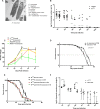
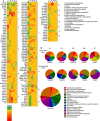
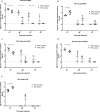
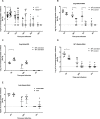
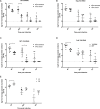


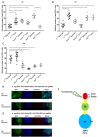
Similar articles
-
Tools for the Genetic Manipulation of Herpetomonas muscarum.G3 (Bethesda). 2020 May 4;10(5):1613-1616. doi: 10.1534/g3.120.401048. G3 (Bethesda). 2020. PMID: 32205316 Free PMC article.
-
Transcriptional and genomic parallels between the monoxenous parasite Herpetomonas muscarum and Leishmania.PLoS Genet. 2019 Nov 11;15(11):e1008452. doi: 10.1371/journal.pgen.1008452. eCollection 2019 Nov. PLoS Genet. 2019. PMID: 31710597 Free PMC article.
-
Drosophila Caliban preserves intestinal homeostasis and lifespan through regulating mitochondrial dynamics and redox state in enterocytes.PLoS Genet. 2020 Oct 15;16(10):e1009140. doi: 10.1371/journal.pgen.1009140. eCollection 2020 Oct. PLoS Genet. 2020. PMID: 33057338 Free PMC article.
-
Ubiquitin signalling in Drosophila innate immune responses.FEBS J. 2024 Oct;291(20):4397-4413. doi: 10.1111/febs.17028. Epub 2023 Dec 18. FEBS J. 2024. PMID: 38069549 Review.
-
JAK/STAT signalling in Drosophila: insights into conserved regulatory and cellular functions.Development. 2006 Jul;133(14):2605-16. doi: 10.1242/dev.02411. Development. 2006. PMID: 16794031 Review.
Cited by
-
The Phlebotomus papatasi systemic transcriptional response to trypanosomatid-contaminated blood does not differ from the non-infected blood meal.Parasit Vectors. 2021 Jan 6;14(1):15. doi: 10.1186/s13071-020-04498-0. Parasit Vectors. 2021. PMID: 33407867 Free PMC article.
-
Immune regulation of intestinal-stem-cell function in Drosophila.Stem Cell Reports. 2022 Apr 12;17(4):741-755. doi: 10.1016/j.stemcr.2022.02.009. Epub 2022 Mar 17. Stem Cell Reports. 2022. PMID: 35303435 Free PMC article.
-
The Role of Gut Microbiota in Shaping Immune Responses in Tephritidae Fruit Fly and Prospective Implications for Management.Neotrop Entomol. 2025 Jan 29;54(1):34. doi: 10.1007/s13744-025-01248-8. Neotrop Entomol. 2025. PMID: 39881025 Review.
-
Tools for the Genetic Manipulation of Herpetomonas muscarum.G3 (Bethesda). 2020 May 4;10(5):1613-1616. doi: 10.1534/g3.120.401048. G3 (Bethesda). 2020. PMID: 32205316 Free PMC article.
-
Flos puerariae ameliorates the intestinal inflammation of Drosophila via modulating the Nrf2/Keap1, JAK-STAT and Wnt signaling.Front Pharmacol. 2022 Aug 17;13:893758. doi: 10.3389/fphar.2022.893758. eCollection 2022. Front Pharmacol. 2022. PMID: 36059974 Free PMC article.
References
-
- Aksoy S, Lehane M and Levashina E (2004) Immune responses and parasite transmission in blood sucking insects Trends Parasitol 20: 433–439 - PubMed
-
- Lehane MJ, Msangi AR (1991) Lectin and peritrophic membrane development in the gut of Glossina m. morsitans and a discussion of their role in protecting the fly against trypanosome infection Med Vet Entomol 5: 495–501. - PubMed
Publication types
MeSH terms
Substances
Grants and funding
LinkOut - more resources
Full Text Sources
Molecular Biology Databases

